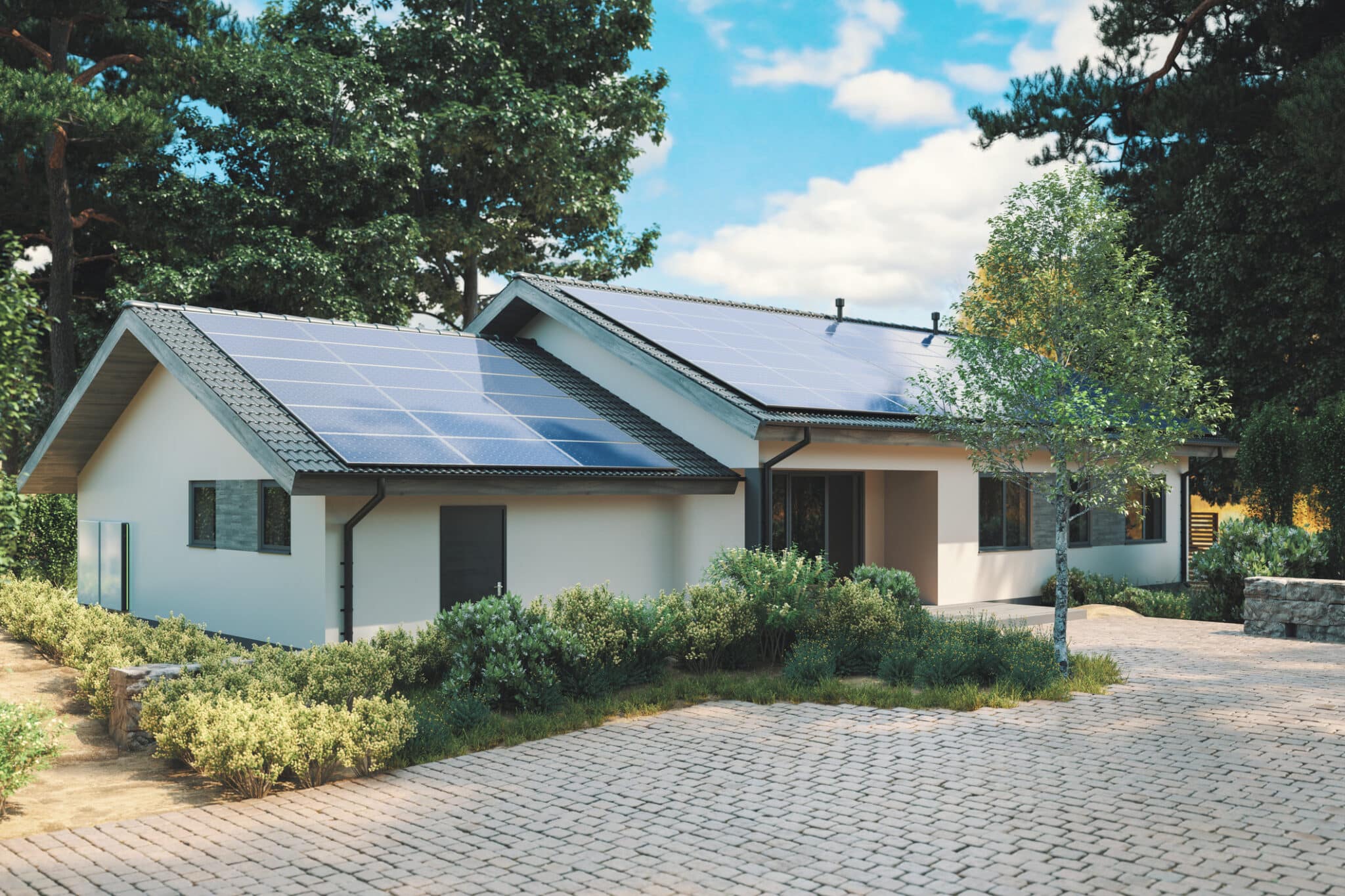Products You May Like
When people think of sustainable homes, they often picture something like a tiny home, a yurt in the mountains or a house made from recycled shipping containers. These small, minimalistic homes may seem ideal for some, but it’s not a feasible — or even a desired — lifestyle for everyone. And that’s OK!
Eco-conscious homeownership can have many different looks, from suburban homes with white picket fences to urban townhomes in the heart of a city. Whether you’re in the process of building a new home or upgrading the one you have, this article is here to guide you on all things eco-friendly home care.
Pick Sustainable Windows
Who doesn’t love a home with lots of natural lighting? Windows are aesthetically pleasing and they also lessen our energy consumption by taking advantage of sunshine as a light and heat source. Investing in good window shades is also a sustainable choice, helping to keep temperatures cooler in the summer without having to crank the AC.

Beyond that, you should evaluate the materials of your new or replacement windows. Cheaply made or outdated glass can be extremely wasteful, leaking about 25-30% of your home’s heat or air conditioning.1 That’s also a big waste of money — Energy Star estimates that switching to energy-efficient windows can save the average homeowner almost $600 per year.2
Still not convinced your window choice makes that big of a difference for the environment? Check out some of these statistics:
- In 2019, residential energy use accounted for roughly 20% of greenhouse gas (GHG) emissions in the U.S.3
- Inefficient windows can cost $50 billion annually in energy waste in the U.S.4
- Replacing single-pane windows can save 1,006 to 6,205 pounds of carbon dioxide per household per year (the equivalent to 51 to 317 gallons of gasoline).5
Choosing energy-star certified energy-efficient windows is the way to go. But there are other window style and material considerations that affect their environmental impact:
- Quality frame materials: You want windows made of durable materials that are going to last a long time. Generally, standard wood window frames are not made to last, but if you live in a favorable climate for them, be sure to purchase windows that have been certified by a green organization. For example, Renewal By Andersen offers reclaimed wood fiber frames certified by Scientific Certification Systems (SCS) Global Services.
- Gas fills: Multi-pane windows often have a layer of gas — non-toxic, odorless gas like argon or krypton — between the panes to increase thermal insulation.
- Low-E glass coating: Low-emissivity coatings control the amount of ultraviolet light and infrared light that can enter your home. This helps improve insulation without blocking visible light.
Check out our guide on the top window replacement companies, vetted for sustainability.
Go Green for Roofing and Gutters
Green Roofing
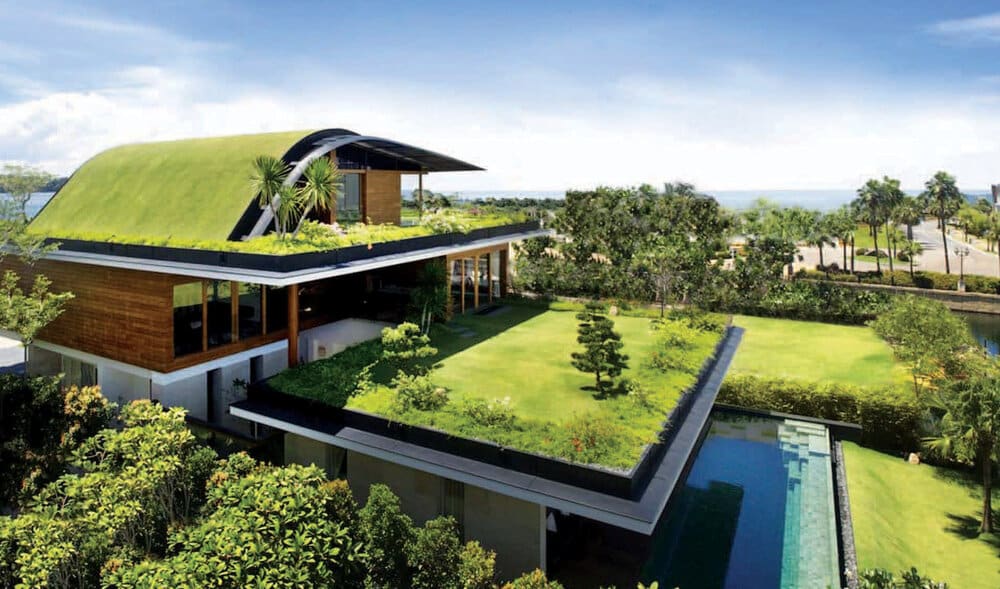
One glance at that photo and you’ll understand how standard roof shingles seem pretty boring in comparison to a green roof!
Simply put, a green roof is a roof that has a top layer of plants. If the above photo seems unattainable, don’t sweat it. That picture is an (incredible but) extreme example of what a green roof can look like. Green roofs come in all sorts of varieties depending on the layout of your home and what type of vegetation will thrive in your climate.
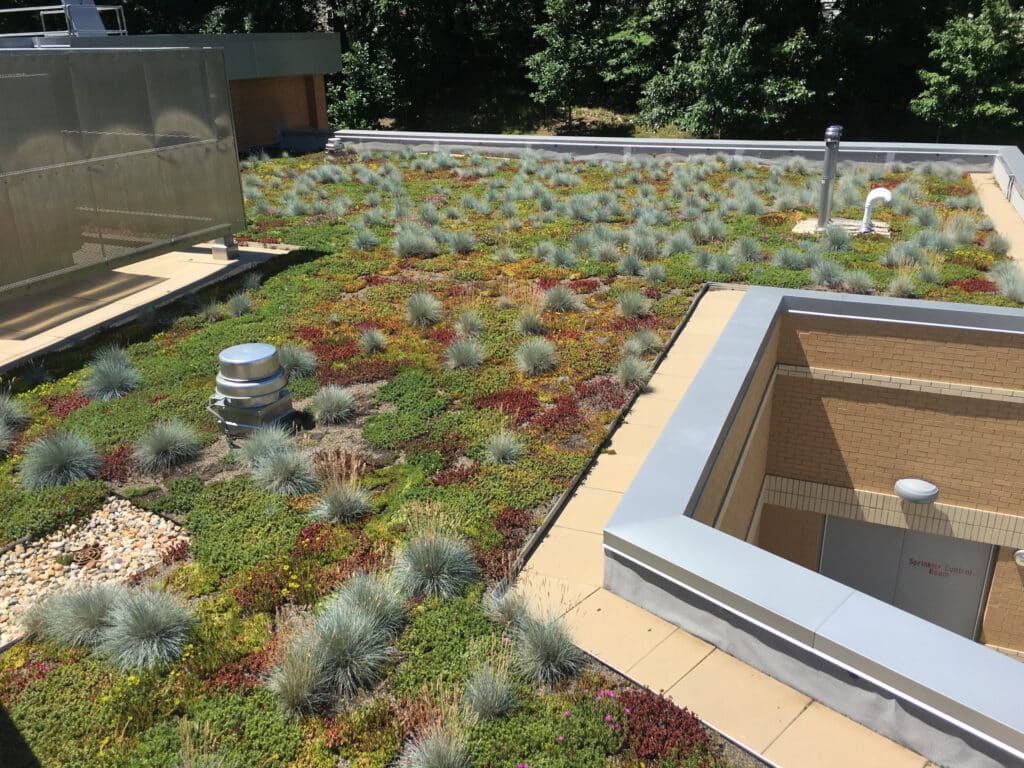
Having a rooftop full of plants not only looks good, but it also has a whole host of environmental, economic, community and even structural benefits, including:
- Absorbing heat to mitigate the “Urban Heat Island Effect” (increased temperatures in places with increased human activity)
- Improving air quality
- Absorbing and filtering rainwater to mitigate flooding and overflow of your local stormwater management system
- Controlling home temperature with improved insulation, lessening energy consumption
- Reducing greenhouse gas emissions
- Extending roof life by protecting the structure from the elements
- Increasing property value and marketability, in some cases.6
A study from the University of Michigan found that, over its estimated lifespan of 40 years, a green roof would save about $200,000, with nearly two-thirds of that coming from reduced energy costs.7
Eco-Friendly Roof and Gutter Materials
If a green roof isn’t an option, you can still make eco-conscious decisions for a more traditional roof. You could consider solar shingles, or opt for a roof made from recycled building materials, rubber or beverage cartons.

Along with your roof, you’ll want to invest in a high-quality gutter system to properly filter rainwater and avoid flooding or home damage. Stay away from gutter materials that contain polyvinyl chloride, better known as PVC. Traditional PVC becomes brittle when exposed to UV light, contains harmful chemicals and is not recyclable. In fact, PVC is banned in Europe because of its damaging effects on humans and the environment.
Instead, look for the following materials, which have a lesser impact on the environment:8
- uPVC (unplasticized PVC)
- Aluminum
- Copper
- Galvanized steel
- Titanium zinc
Also, consider attaching your gutters to a rain barrel or other rainwater catchment system to use for watering your lawn or nonedible plants.
Invest in Solar Energy
We briefly mentioned solar shingles, but adding a solar roof or traditional rooftop solar panels is one of the best sustainable home improvements you can make. By investing in a renewable energy system, you rely less on traditional energy sources and generate your own electricity. So not only are you cutting down on your environmental footprint, but you’re also reducing — or even eliminating — your electric bills.
In even better news, the cost of going solar has dropped more than 70% over the last decade, and more and more states are offering financial solar incentives to those who make the switch.9
Still, solar panels are a hefty expense, so you’ll want to be sure that going solar is worth it where you live. Most homeowners find that the cost of solar pays off over time.
If you’re not a good candidate for rooftop solar panels, here are some other ways you can take advantage of solar energy in your home:
Choose Eco-Friendly Building Materials

Scientists have become creative when it comes to recycling everyday products into usable building materials. These days, there are homes made from newspaper wood, glass bottles or mushroom bricks, earth-packed car tires, upcycled plastics, shipping container scraps… the list goes on.10 While some of these materials create more innovative-looking homes, others are so discreet you may not even do a double-take while walking past.
If you’re looking for more natural materials that are eco-friendlier, consider stone, cob, bamboo, cork, adobe brick or straw bale. (If the last one has you thinking back to the story of the Three Little Pigs, know that straw bale homes are often covered with plaster. So no, you don’t have to worry about a big gust of wind — or a big bad wolf — blowing your house down.)
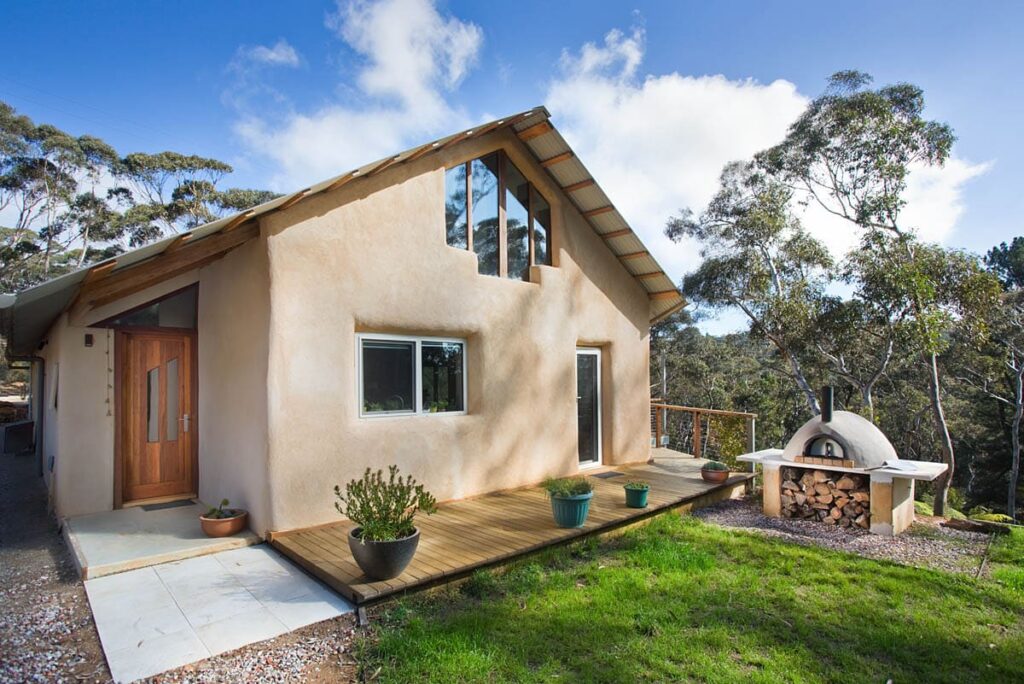
When it comes to flooring and walls, materials like recycled steel or reclaimed wood are a good bet. Sadly, many popular building woods — including mahogany, rosewood and ebony — are irresponsibly sourced from our rainforests. So look for building materials that are certified by the Rainforest Alliance or another credible organization.
For paint, opt for brands that are Greenguard certified or ones that contain little-to-no volatile organic compounds (VOCs).
Evaluate Water Usage
Depending on where you live, water may or may not be considered a precious resource. Regardless, it should always be treated as one. According to the Environmental Protection Agency, the average household wastes 9,400 gallons of water per year, while household leaks collectively waste about 900 billion gallons per year.11
Of course, there are some things you can do to save water at home, like taking shorter showers and only running the dishwasher when it’s full. But making some of the following home upgrades is a surefire way to waste less water:
- Install low-flow showerheads: Standard showerheads use up to 2.5 gallons of water in a single minute. A low-flow showerhead diminishes the flow of water without compromising effectiveness.
- Install faucet aerators: Similar to the low-flow showerhead, a faucet aerator is a small metal screen that creates a wider stream of water from your faucet so water can be used more efficiently.
- Consider a greywater system: Greywater is the lightly used water from showers, sinks, washing machines and other places in the home that often just goes down the drain. A greywater system helps collect this water so that it can be repurposed for other areas of your home. While a professional greywater system installation can be expensive, you may find the savings worth it. Or, check out Greywater Action for more tips on how to DIY a greywater system.
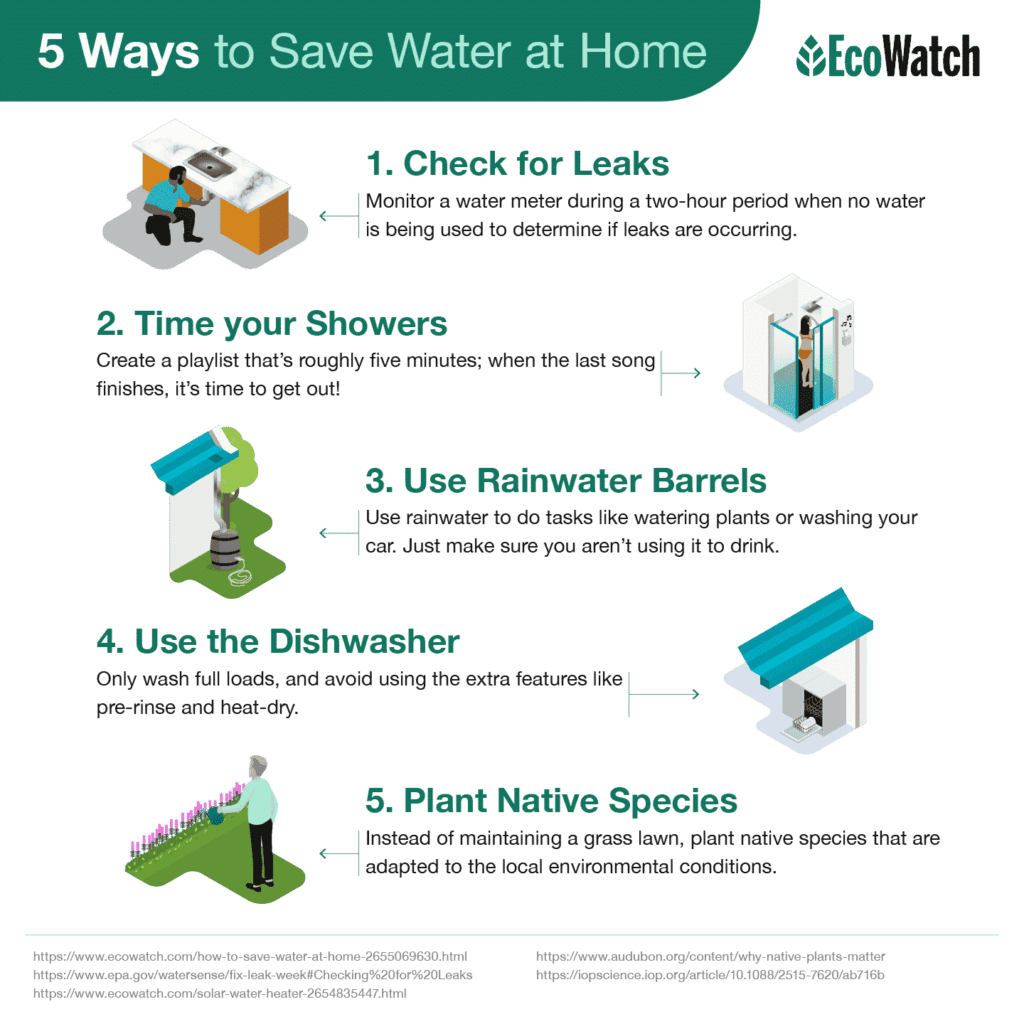
Buy Energy-Efficient Appliances and Lighting
This one is probably a no-brainer. We already touched on solar-powered appliances and lights, but if your home is not a good candidate for solar, Energy Star-certified appliances and lights are a good option.
Energy-efficient appliances and lights will cost you a bit more upfront, but they’re shown to save homeowners a lot of money over time by consuming less energy and requiring less maintenance. For example, just switching to LED lightbulbs can save the average homeowner about $225 per year.12
Here’s a list of some of the most common household appliances that have Energy Star-certified models:
- Refrigerators and freezers
- Dishwashers
- Washers and dryers
- Air conditioners and heaters
- Smart thermostats
- Water heaters
- Ceiling fans
- Televisions
- …and more13
Don’t forget about other appliances you can add to your home to improve its sustainability, like a composter for food scraps, air purifiers, and space heaters to use in place of central heating.
Insulate, Insulate, Insulate
A well-insulated home is a sustainable home. According to the Department of Energy, a properly insulated attic can reduce your energy bill by 10% to 50% — and that’s just the attic!14
If you’re upgrading an existing home, you’ll want to check the current insulation and conduct an energy audit to note any potential air leaks in walls, windows and door frames. These are some of the most common areas you should check for insulation:
- Attic: Between and over floor joists; around the access door
- Exterior walls: Between living spaces and unheated garages, shed roofs or storage areas; foundation walls above ground level; foundation walls in heated basements
- Floors: Around vented crawl spaces, garages and where they meet the wall
- Windows and doors: Caulk and seal around all openings
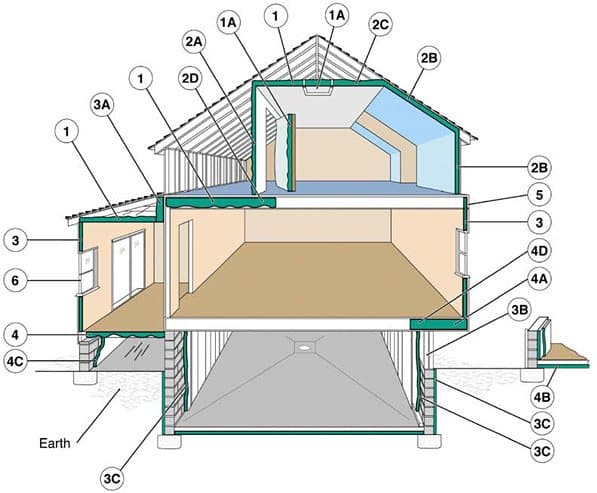
Eco-conscious homeowners will want to pay attention to the materials used for insulations as well. Unfortunately, traces of asbestos have been found in the insulation of a lot of older homes, and even newer products can contain harmful chemicals. The most eco-friendly insulation options include mineral wool, cork or recycled cotton denim.
Building an Eco-Friendly Home: Certifications to Look For
If you’re working with a contractor to build the eco-friendly home of your dreams, make sure you’re upfront about your wishes and always check where your building materials are coming from before you purchase anything. Here’s a list of companies and organizations that offer “green” certifications for common building products:
- BREEAM
- Cradle to Cradle
- Energy Star
- Electronic Product Environmental Assessment Tool (EPEAT)
- FloorScore
- Forest Stewardship Council (FSC)
- Greenguard
- Green Seal
- Leadership in Energy and Environmental Design (LEED)
- Rainforest Alliance
- Safer Choice
- Scientific Certification Systems (SCS)
- Smart Certified
- Sustainable Forestry Initiative (SFI) Chain of Custody
- Water Sense
So there you have it — you don’t have to live in a yurt in the mountains to have a sustainable home. (Although, it would be pretty cool if you did.) If you’re not sure where to start with eco-friendly home upgrades, try reaching out to your local utility provider or a solar energy company near you. Many of them offer free energy-efficiency audits or can offer some guidance on sustainable improvements.
